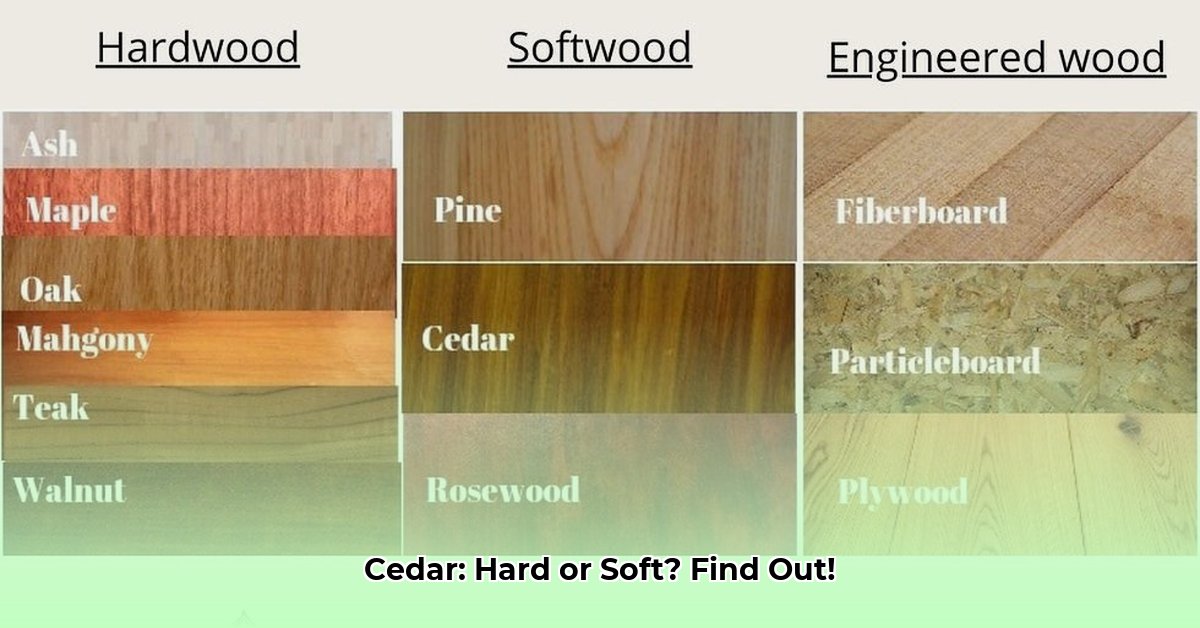
Cedar's classification as a softwood often leads to misconceptions about its strength and durability. While technically a softwood (from coniferous trees), different cedar species exhibit significant variations in properties. This comprehensive guide clarifies cedar's multifaceted nature, helping you choose the right type for your project. We’ll explore its properties, compare it to hardwoods, and provide practical guidance for selection and care.
Understanding Cedar's Softwood Classification
Is cedar a hard or softwood? The answer is: softwood. This classification stems from its coniferous origins, meaning it comes from cone-bearing trees with needles, unlike hardwoods from deciduous trees that lose their leaves. However, "softwood" doesn't equate to weakness. Different cedar species possess unique properties affecting their strength, durability, and suitability for specific applications. This nuance is critical for informed decision-making.
Cedar Species and Their Properties: A Detailed Look
Several cedar species are commonly used, each with distinct characteristics. Let's examine three popular choices: Western Red Cedar (WRC), Alaskan Yellow Cedar (AYC), and Eastern Red Cedar (ERC).
| Cedar Type | Janka Hardness (lbs) | Compressive Strength (psi) | Bending Strength (psi) | Density (lbs/ft³) | Rot Resistance | Insect Resistance | Aroma |
|---|---|---|---|---|---|---|---|
| Western Red Cedar | 350-500 | 3500-5000 | 8000-12000 | 22-28 | Excellent | Excellent | Mild |
| Alaskan Yellow Cedar | 500-700 | 5000-7000 | 12000-18000 | 30-36 | Excellent | Excellent | Strong |
| Eastern Red Cedar | 300-400 | 3000-4000 | 7000-10000 | 20-26 | Good | Good | Pleasant |
(Note: These values are approximate and can vary based on growth conditions and moisture content.)
The Janka hardness scale measures resistance to denting. As you can see, Alaskan Yellow Cedar significantly surpasses Western Red and Eastern Red Cedar in hardness and strength. This highlights the importance of specifying the cedar type when assessing its suitability for a project.
Cedar vs. Hardwood: A Comparative Analysis
While cedar exhibits lower strength than hardwoods like oak or maple in compression and bending tests, its advantages lie in other areas. Cedar's natural oils provide exceptional rot and insect resistance, making it ideal for exterior uses. Hardwoods, while stronger, may lack this crucial defense against decay. The choice depends on the priorities of your project: strength versus decay resistance.
Applications of Cedar: Where it Excels
Cedar’s natural resistance to decay makes it a preferred choice for exterior projects, including:
- Siding: Cedar's aesthetic appeal and weather resistance make it a popular choice for siding.
- Fencing: Durable and long-lasting, cedar fences can withstand harsh weather conditions.
- Decking: Its natural beauty and resistance to rot contribute to deck longevity.
- Outdoor Furniture: Cedar's lightweight yet durable nature suits outdoor furniture. This is especially true when considering its pleasing aroma.
However, avoid using cedar in load-bearing applications where high compressive strength is crucial, such as supporting beams in a house. For such uses, hardwoods are far more suitable.
Selecting and Caring for Cedar: A Practical Guide
Choosing the right cedar involves considering several factors:
- Project Requirements: Define the project's needs. High-strength applications require AYC, while less demanding ones can use WRC or ERC.
- Budget: AYC typically commands a higher price than WRC or ERC.
- Aesthetic Preferences: Consider color and grain variations amongst the species.
- Availability: Check local lumber yards for species availability and pricing.
Proper sealants enhance cedar's durability by protecting it from moisture and UV damage, extending its service life considerably.
Conclusion: Choosing the Right Cedar for Your Needs
The question "Is cedar a hard or softwood?" is only the starting point. The specific species, project requirements, and budget all influence your cedar selection. A thorough understanding of each cedar type's properties empowers you to make informed choices, ensuring successful and long-lasting projects. Remember that variations in properties exist even within species, and ongoing research may introduce new nuances to our understanding.